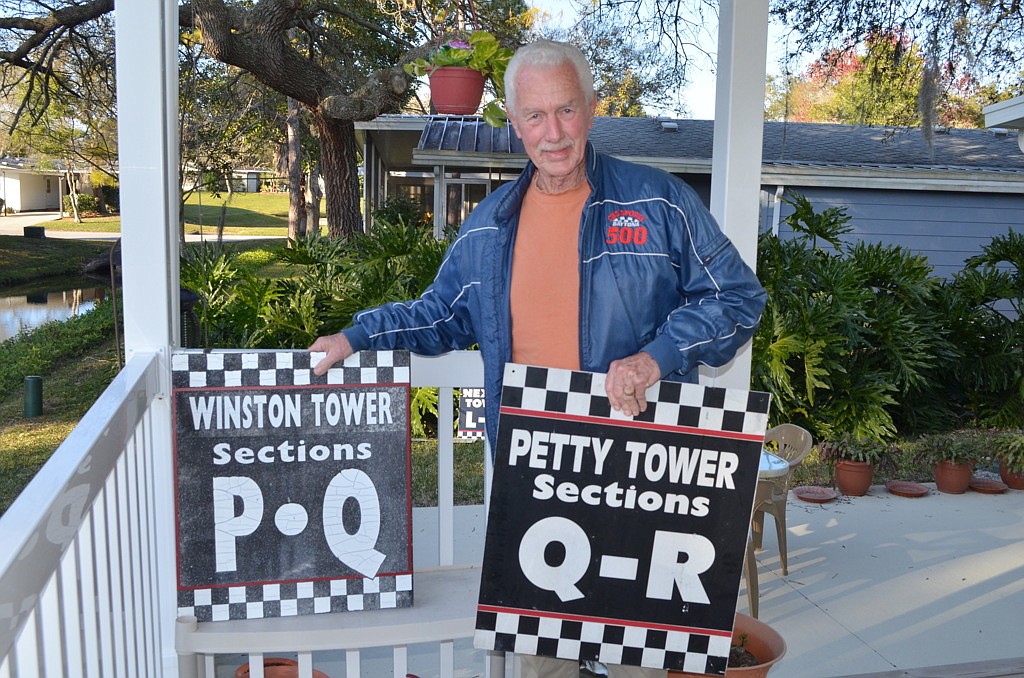- April 19, 2024
-
-
Loading

Loading

From sand to asphalt, he never missed a race.
Bill France Jr. showed an early interest in racing. George Pilcher, of Ormond Beach, a friend and schoolmate, said Bill Jr. would organize bike races when they were in middle school in the 1940s.
“He would charge everybody a quarter and there would be first, second and third prizes,” Pilcher said.
That’s just one of the memories Pilcher, 81, an FPL retiree, has of racing and the France family after working the races every year since 1947. He started at the beach races, spent 32 years as head usher at the Speedway and now works at the Daytona 500 Club greeting guests.
But he said there are many other people who can tell stories.
“Everybody who has been here a long time has their own memories,” he said.
Bill Jr. was the son of “Big Bill” France, who started NASCAR. The senior France was a tall man who commanded attention.
“He was nice but you respected him. When he talked, you listened,” Pilcher said. “He was an awesome dude.”
Beach races were wild
For the beach races, Bill Jr. and Pilcher installed stakes across the beach and the dunes, and then to the scrub on the other side of State Road A1A. Everyone was then charged admission to get on the part of the beach. They had to watch for cars that were low in the back because people sometimes tried to sneak in by hiding in the trunk.
Pilcher also sold hot dogs and soft drinks.
“We’d do anything for a dollar an hour back then,” he said.
Today, the race starting times have a lot to with TV coverage, but back then they were determined by the tides. They would start the race as the tide was going out.
Pilcher said the drivers would start three abreast and speed down the beach toward the north turn. They would almost get sideways making the turn, sending clouds of marl dust from the beach ramp.
“It was wild,” he said.
State Road A1A was straighter in those days and the drivers would race down the road.
At the south turn, there was an area of Palmetto scrubs they could drive into if they didn’t make the turn.
On the beach side of the turn, there was a huge pile of sand where a driver would sometimes crash. Pilcher said they would push the driver out, if they liked him.
The pits consisted of tarps spread out on the sand. Drivers would stop for new tires or a carburetor adjustment.
After the race, Pilcher and Bill Jr. would take the suitcases of money with a police escort to the France home, where they would count it on a dining room table.
Bill Jr. eventually took over NASCAR when his father died, and led the organization through many growth years.
Pilcher also knows Jim France, a quiet man who always worked effectively out of the public eye.
Racing with Bill Jr.
Pilcher said he noticed a competitiveness in Bill Jr. when they were young. They were driving up A1A to go on a field trip to Marineland, and Bill Jr. tried to pass Pilcher, but Pilcher blocked him. Bill Jr. then passed him with two tires off in the sand.
When the Speedway opened in 1959, Pilcher was given a pair of white overalls and assigned to taking tickets. He later advanced to head usher where he worked until 2004.
Pilcher never missed a chance to work a race. When stationed in Pensacola while in the Navy, he would take leave and hitchhike home to work the races.
He also worked as a spotter. He would sit above pit row and watch four of the cars. He would watch what they did, such as change tires or add gasoline, and then call the office so it could be broadcast.
The day Reagan came to town
One of the more difficult days of ushering was when President Ronald Reagan attended a race. Pilcher had to give the Secret Service all the names of the ushers for background checks. He had a hard time getting into the track himself, because the security was so tight.
He also remembers when they had to notify a fan that her father had died. They had a chair for her and some water and tissues. She came back later and thanked them for their courtesy.
He said he enjoyed all those years, mostly because he saw friends coming back each year.
“It was like a family reunion,” he said. “I had a family, a mother and four kids, all working in the Campbell Grandstand.”
He said he also enjoyed helping the fans have a good time.
In 2004, the Daytona 500 Club started, which offers a higher level of racing experience for fans, and that’s where Pilcher has worked since. He gives tours and also takes care of any problems in the facility.
“I know all the elecrticians and plumbers and know who to call,” he said.
The biggest thing, he said, is that he hands out Hershey Kisses to the ladies when they come in.
“I love it,” he said.
Sponsors are important today, and were also important back in the old days. Once when a Plymouth won a race, a film of the race was placed on an airplane and flown to New York so it could be shown on the Ed Sullivan show. Plymouth was a sponsor of the show.
“It started as a sport and now it’s a sport and a big business,” he said.